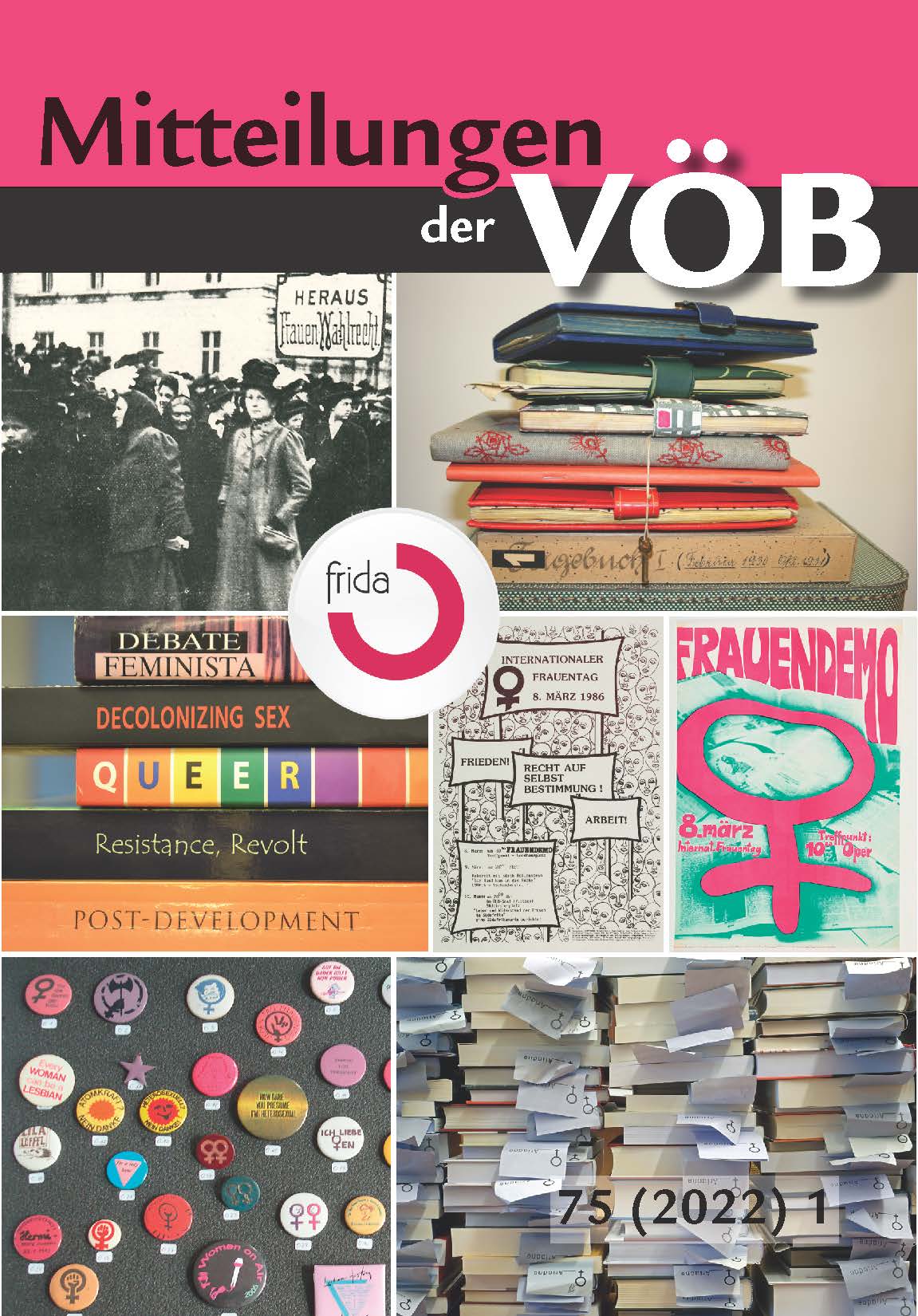Gender in Comics? Questions and answers on the research project "Visualities of Gender in German-language Comics"
DOI:
https://doi.org/10.31263/voebm.v75i1.7214Keywords:
comics, gender, autographyAbstract
The project Visualities of Gender in German-language Comics, funded by the FWF and located at the Department of German Philology at the University of Vienna, systematically investigates how gender is narrated in comics through linguistic and visual codes and to what extent gender norms are discussed. The article presents the research project, its conception and goals, the corpus as well as the essential database and, last but not least, its theoretical approaches. In addition, characteristics of comics with regard to gender and points of contact with frida are addressed. Indeed, comics by women, including numerous autobiographical works, have been an integral part of the comics boom of recent decades. Even more so, comics by and for women appear to be an appropriate medium for taboos, articulating illness, sexuality, trauma, violence, and injuries of various kinds in a way that is of both personal and societal interest. Auto_biographical documents are important elements of these artistic explorations. One example is Ulli Lust’s autobiographical comic Today is the Last Day of the Rest of Your Life (2009).
Downloads
References
Abel, Julia und Christian Klein (Hg.) (2016): Comics und Graphic Novels. Eine Einführung, Stuttgart: Metzler. https://doi.org/10.1007/978-3-476-05443-2
Babka, Anna (2002): Unterbrochen. Gender und die Tropen der Autobiographie, Wien: Passagen.
Bramlett, Frank; Cook, Roy T. und Meskin, Aaron (Hg.) (2017): The Routledge Companion to Comics, London and New York: Routledge.
Butler, Judith (1993): Bodies That Matter. On The Discursive Limits of Sex, New York: Routledge.
Butler, Judith (1990): Gender Trouble. Feminism and the Subversion of Identity, New York: Routledge.
Chute, Hillary L. (2010): Graphic Women. Live Narrative & Contemporary Comics, New York: Columbia UP.
Chute, Hillary L. (2017): Why Comics? From Underground to Everywhere, New York: HarperCollins.
Dolle-Weinkauff, Bernd (2014): Comic, Graphic Novel und Serialität, in: Bild ist Text ist Bild. Narration und Ästhetik in der Graphic Novel. Hg. v. Susanne Hochreiter und Ursula Klingenböck, Bielefeld: transcript, 151–168. https://doi.org/10.1515/transcript.9783839426364.151
Dolle-Weinkauff, Bernd (2008): Comics made in Germany. 60 Jahre Comics aus Deutschland 1947–2007. Unter Mitarbeit v. Sylvia Smus und Brita Eckert (2. durchges. Aufl.), Wiesbaden: Harrassowitz Verlag (= Gesellschaft für das Buch 10).
Foster, Hal (1988): Vision and Visuality, Seattle: Bay Press.
Frahm, Ole (2010): Die Sprache des Comics, Hamburg: Philo Fine Arts.
Frahm, Ole (2014): Die Fiktion des Graphischen Romans, in: Bild ist Text ist Bild. Narration und Ästhetik in der Graphic Novel. Hg. v. Susanne Hochreiter und Ursula Klingenböck, Bielefeld: transcript, 53–77. https://doi.org/10.1515/transcript.9783839426364.53
Gardner, Jared (2008): Autobiography’s Biography, 1972–2007, in: Biography 31 (1), 1–26. https://doi.org/10.1353/bio.0.0003
Grünewald, Dietrich (2010): Das Prinzip Bildgeschichte. Struktur und Geschichte der Comics, in: Beiträge zur Comicforschung. Hg. v. Dietrich Grünewald, Bochum und Essen: Ch. A. Bachmann, 11–31.
Hatfield, Charles und Bart, Beaty (Hg.) (2020): Comics Studies. A Guidebook, New Brunswick: Rutgers University Press.
Hochreiter, Susanne (2014): Heldinnen und keine. Zu Genre und Affekt in Ulli Lust Heute ist der letzte Tag vom Rest deines Lebens, in: Bild ist Text ist Bild. Narration und Ästhetik in der Graphic Novel. Hg. v. Susanne Hochreiter und Ursula Klingenböck, Bielefeld: transcript, 233–256. https://doi.org/10.1515/transcript.9783839426364.233
Jenkins, Henry (2012): Introduction: Should We Discipline the Reading of Comics?, in: Critical Approaches to Comics. Theories and Methods. Hg. v. Matthew J. Smith und Randy Duncan, New York und London: Routledge, 1–14.
Klar, Elisabeth (2014): Transformation und Überschreibung. Sprache und Text in ihrer Beziehung zum Körper-Zeichen in den Comics von Alfred, in: Bild ist Text ist Bild. Narration und Ästhetik in der Graphic Novel. Hg. v. Susanne Hochreiter und Ursula Klingenböck, Bielefeld: transcript, 169–189. https://doi.org/10.1515/transcript.9783839426364.169
Lust, Ulli (2009): Heute ist der letzte Tag vom Rest deines Lebens, Berlin: Avant.
Schmitz-Emans, Monika (2012): Literatur-Comics. Adaptionen und Transformationen der Weltliteratur, Berlin and Boston: De Gruyter. https://doi.org/10.1515/9783110266764
Schüwer, Martin (2008): Wie Comics erzählen: Grundriss einer intermedialen Erzähltheorie der grafischen Literatur, Trier: WVT.
Serles, Katharina (2018): BILDER SEHEN ERZÄHLEN. Kunstbetrachtung im Comic, in: CLOSURE. Kieler e-Journal für Comicforschung 4.5, 134–146. Online unter: http://www.closure.uni-kiel.de/closure4.5/serles
Downloads
Published
How to Cite
Issue
Section
License
Copyright (c) 2022 Susanne Hochreiter, Marina Rauchenbacher, Katharina Serles

This work is licensed under a Creative Commons Attribution 4.0 International License.

Alle Inhalte dieser Zeitschrift – exkl. einzelner Logos und Abbildungen – sind lizenziert unter CC BY 4.0.










